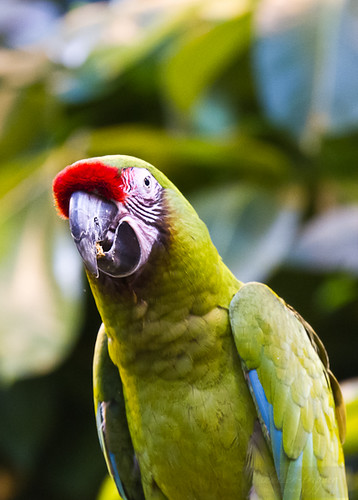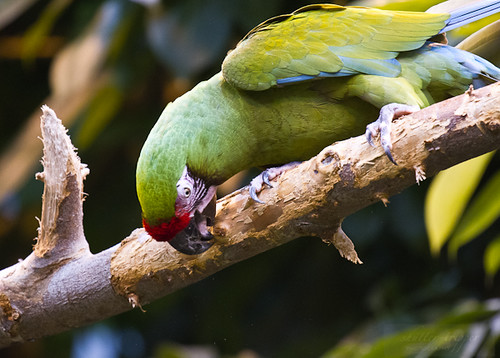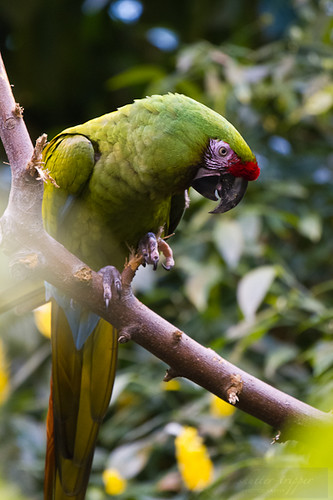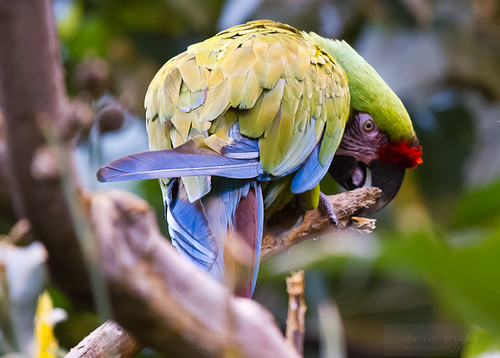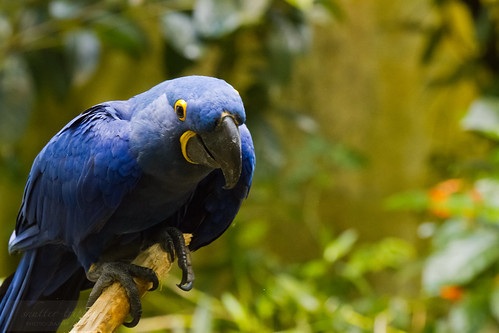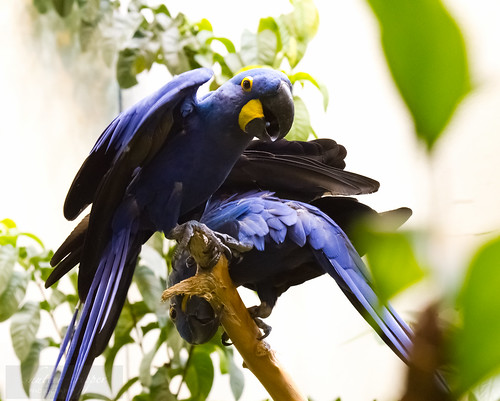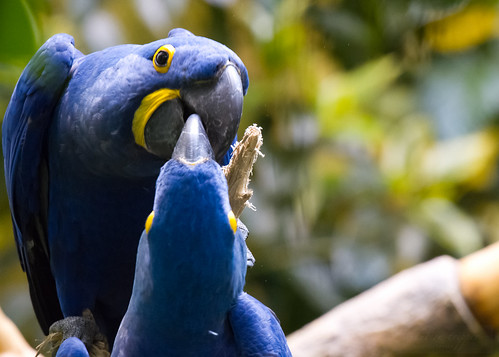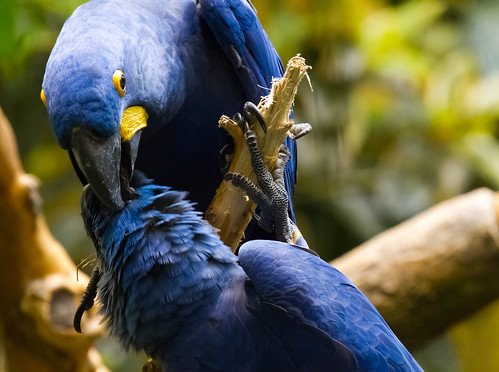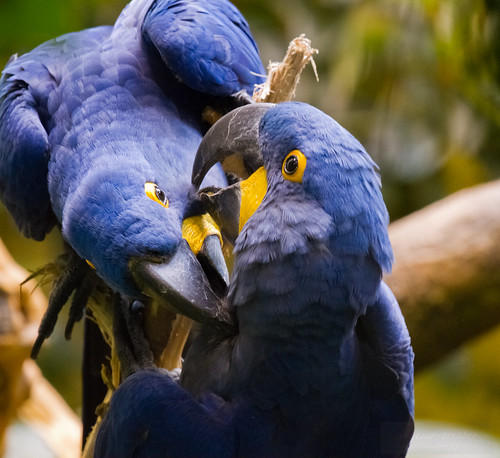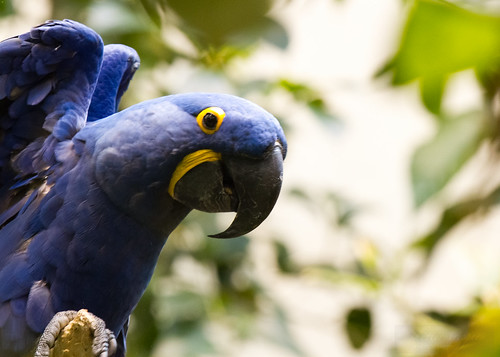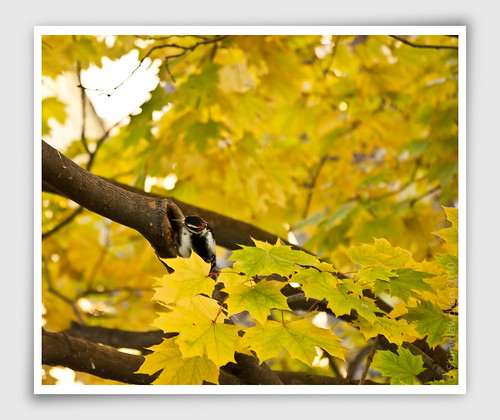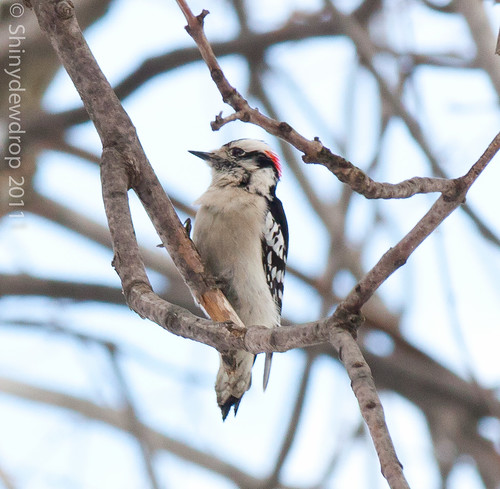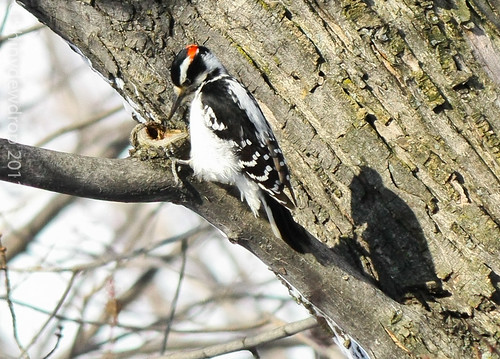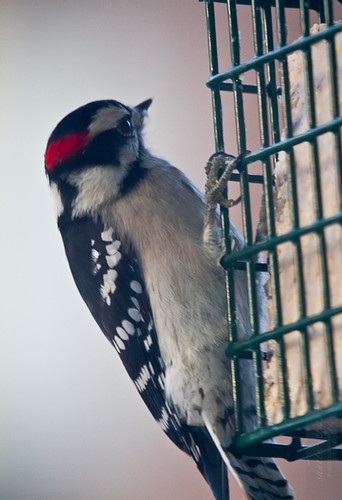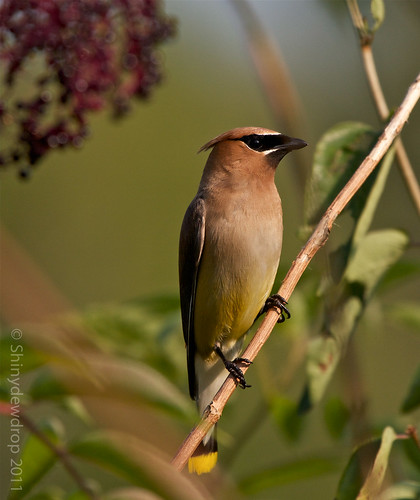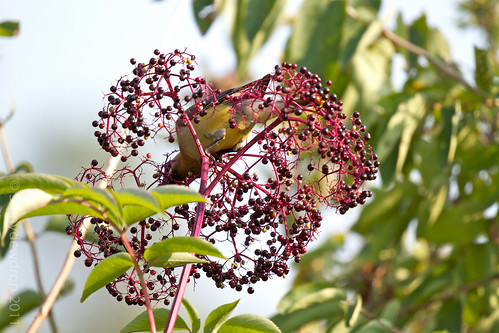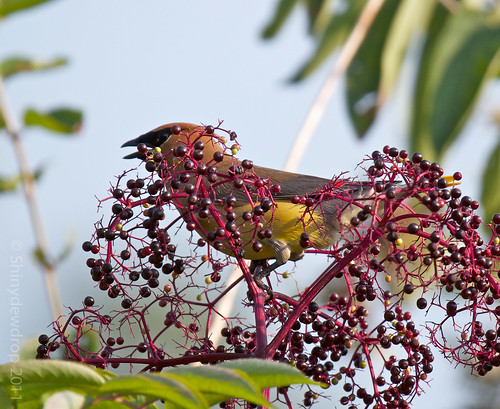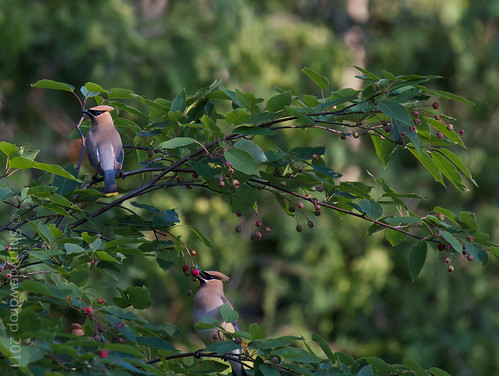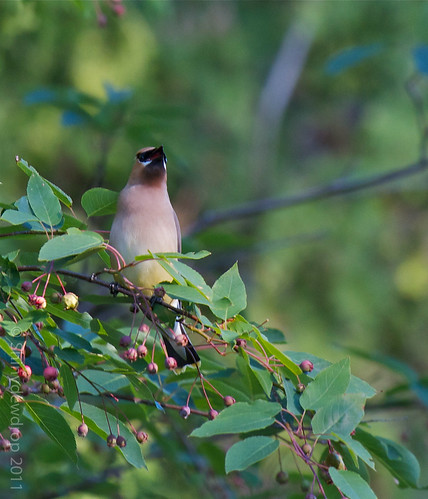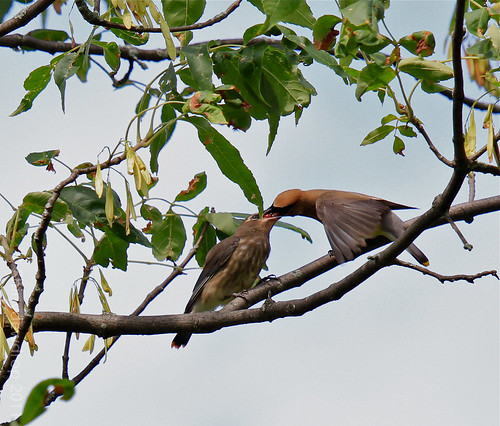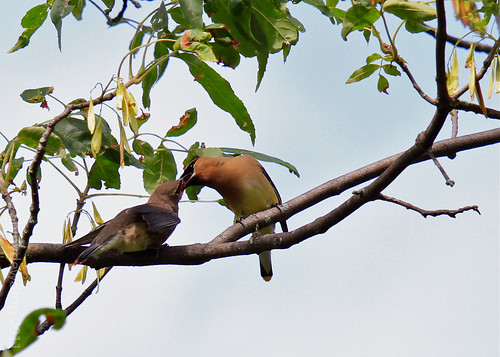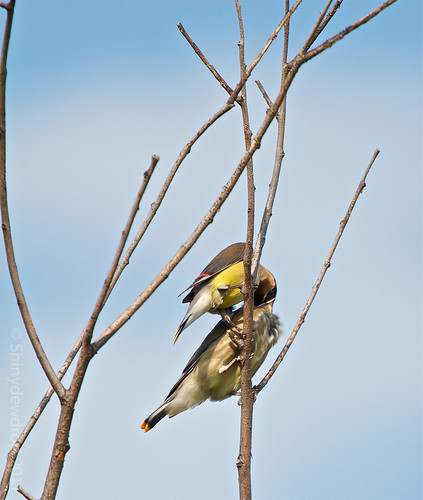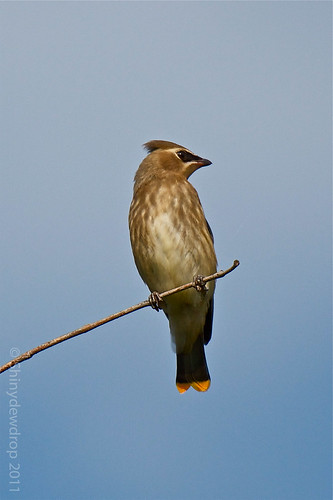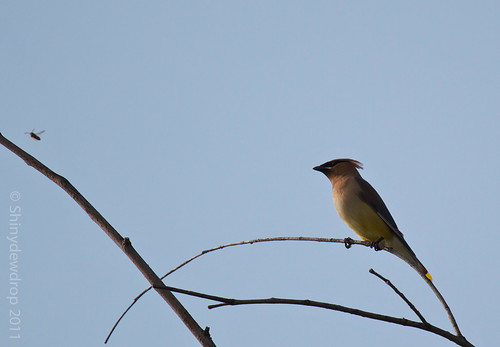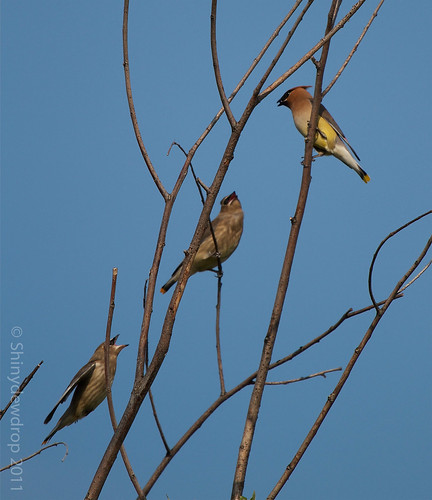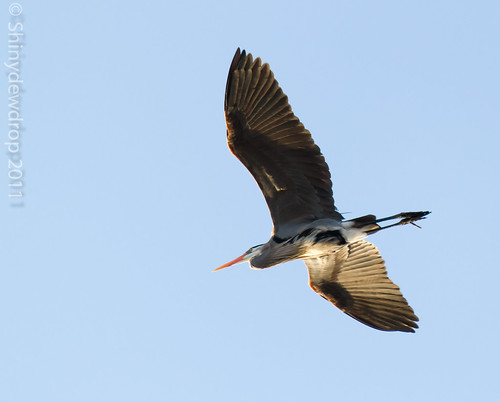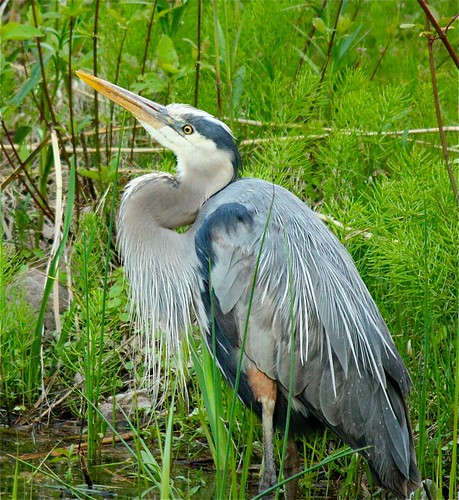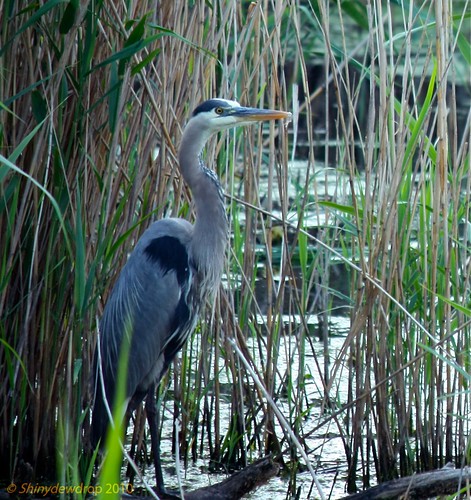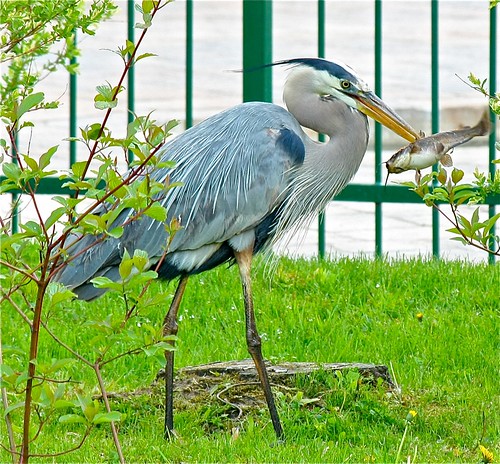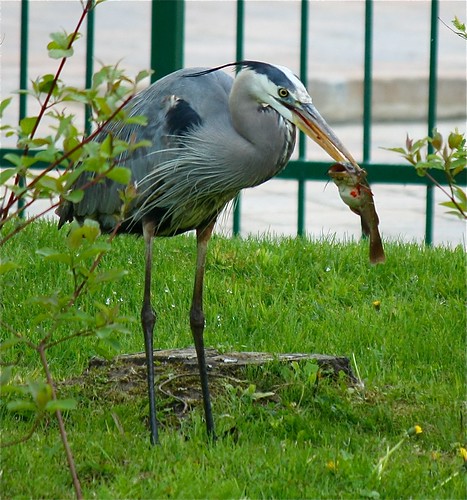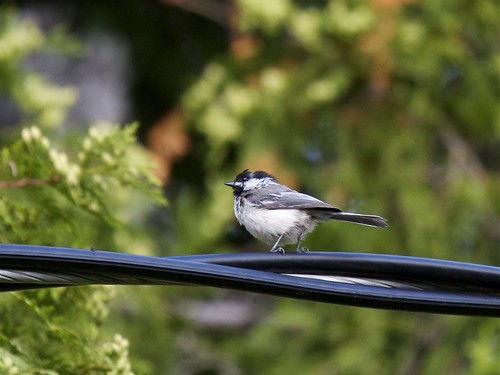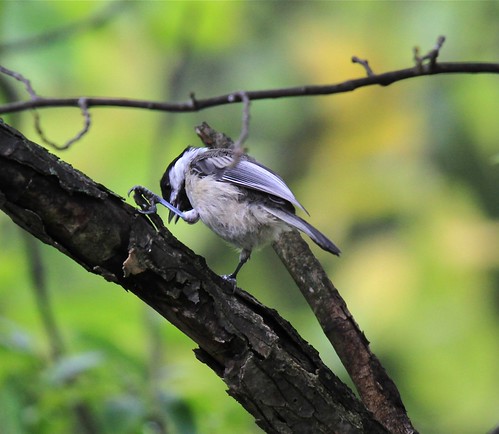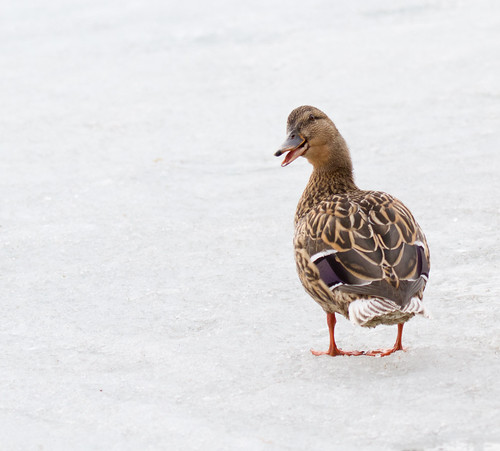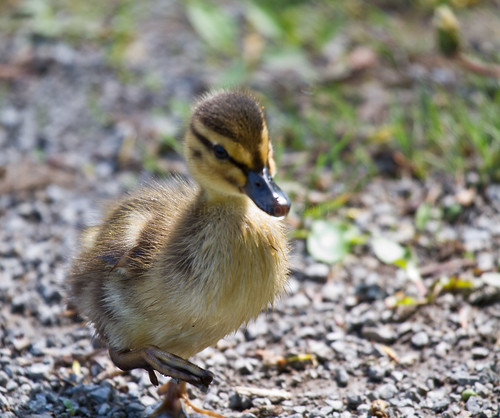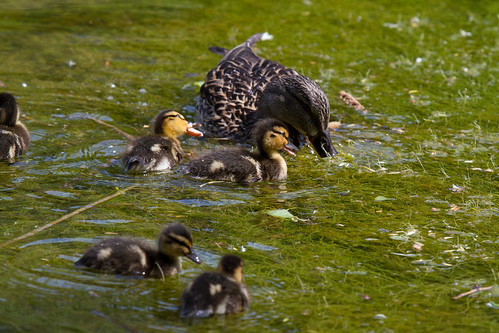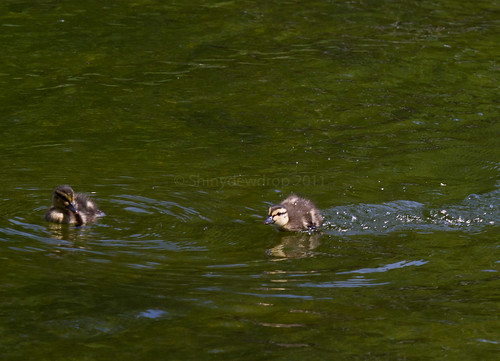I got my second opportunity to see such brightly feathered birds in one day - the same day that I saw the Hyacinth Macaws. Loud and raucous like their blue cousins, I found the pair too busy stripping the tree of its bark and not really paying much attention to each other. So much so that I couldn't get a shot of them together despite my hanging around them for a while in the hopes they'd oblige me.
They appeared to be very curious birds by nature and really intent on what they were doing. I'm not sure whether they were actually eating the bark or just pecking at them in an attempt to gather nutrients.
Again, as with the Hyacinth Macaws, I had a great challenge photographing these birds in extremely low light. A long and heavy lens just didn't help and you will notice the slightly soft focus in some of the images. This happened for mainly two reasons, though - one of course was the low shutter speed, causing the pictures to be on the softer side, and the other one is the extreme application of noise reduction in post that softened out the details a little bit as well. However, I only got a handful of shots and these were some of them.
My Feathered Friends
One of my favourite things to do outdoors is birding - find new bird species, photograph them, identify them and then learn about their behaviour, habitat, feeding and especially their songs and calls, so I can identify them when I hear them again. I will try to include as many pictures and as much information I can in these posts and I would love to hear about your birding experiences. Do you have some special stories to share? Do you have some tips to help me in the field?
Thursday, March 1, 2012
Military Macaw (Ara militaris)
Labels:
colourful birds,
green macaw,
large parrot,
Macaw,
Military Macaw,
Montreal Biodome,
Tropical birds
Monday, February 20, 2012
Hyacinth Macaws
I visited the Montreal Biodome over the weekend and was fascinated by this pair of Hyacinth Macaws. I heard their screams from afar, but thought that it was the pair of Military Macaws creating the ruckus. But upon approaching the pair of Military Macaws, I realized that they weren't the only ones guilty of the loud squawks and later turned around and found this pair courting.
I had the worst light possible, being in the Rainforest region in the Biodome. The tropical vegetation was dense and therefore, the light was scarce. I shot these images at ISO 3200 and had to remove quite a bit of noise in Lightroom. The angles could have been better if I didn't have to shoot in between the bobbing heads of the visitors and being careful not to bump my lens into their heads either. Everyone seemed enthralled by this pair. Beautiful birds! I'm definitely going back to see them again.
I had the worst light possible, being in the Rainforest region in the Biodome. The tropical vegetation was dense and therefore, the light was scarce. I shot these images at ISO 3200 and had to remove quite a bit of noise in Lightroom. The angles could have been better if I didn't have to shoot in between the bobbing heads of the visitors and being careful not to bump my lens into their heads either. Everyone seemed enthralled by this pair. Beautiful birds! I'm definitely going back to see them again.
Labels:
bird,
blue macaw,
courting birds,
Hyacinth Macaws,
Macaw,
Montreal Biodome,
parrots,
Tropical birds,
wild bird,
wildlife
Friday, January 6, 2012
Downy Woodpecker (Picoides pubescens)
It's been ages since I posted anything about my birding activities and thought that I should set that right. Right now, or it will be put on the back burner again!
Lighting note: I have to confess that these shots aren't very sharp because they were mostly taken from behind dirty glass windows on a fairly overcast day, or should I say late afternoon? For the feeder shots, I used a flash which I bounced off a white board to diffuse the light on the bird and set the flash up at an angle to eliminate the reflection on the glass. The images of the birds in the trees were taken in natural light.
Since I recently hung up a suet feeder on my balcony, a male Downy Woodpecker has been a daily visitor, visiting several times a day. I also saw a White-breasted Nuthatch on the first couple of days, but somehow haven't seen him after that. Maybe the Downy is hogging the feeder and doesn't allow anyone else to partake of the tasty suet cake.
Downy Woodpeckers are fairly tiny birds that are primarily black and white with predominantly black upperparts, white-spotted black wing feathers, and a white back and belly. The adult males have a red cap, which is missing in females, but the juvenile males often have a small red crown.
It can be very tricky to differentiate between the Downy and the Hairy Woodpecker. They both look almost exactly the same except the Downy has a shorter beak than the Hairy Woodpecker, and the Hairy is slightly larger in size as well. There is also a difference in the colouring of the tail feathers, but I find it hard to distinguish from a distance. Just to demonstrate the difference between these species, note the bill sizes in the following images:
These birds are not migratory and I have seen them all year round in the little park in front of my building. Seeing that they visit a neighbour's feeder, I thought of getting one of my own. And ever since then, the little birdie has been honouring me with his visits. They primarily peck on the bark surface of trees during the summer but have to dig deeper during the winter months. Since it's difficult to come by insects during the winter, they tend to feed on leftover berries on the trees or at backyard suet feeders, like mine.
Originally, I had hung the feeder on the hook that wasn't quite visible from inside, and photographing the birds at the feeder would be difficult through a double-glass window with a screen to boot. There were quite a few birds visiting the suet feeder, including chickadees, starlings, a nuthatch and of course the house sparrows. I had an idea - I decided to move the feeder over to the other hook which was more visible, and I could push the mesh screen over to the other side to get a clearer view. And there was no double-glass there. I also thought it would be really interesting to watch what the birds do with this relocation.
Very interestingly, the woodpecker flew into the balcony at the exact level at which the suet feeder had been suspended in its original location, and when he flew in he floundered and clawed the air for a second unable to find his perch! He was very taken aback and somehow found his wings, so to speak and flew over to the wall and sat there looking very surprised. He spied the feeder at the new location within a second of course, and then flew over to it.
As I had guessed, he didn't start feeding right away - he sat there, hanging on to the feeder, looking all around him. I was standing very close to the glass door and he definitely saw me because he sat there watching me for at least a couple of minutes. When he perceived no threat from me, he went about warily pecking at the suet cake. Very interesting but predictable behaviour.
I'm yet to see his female counterpart and I'm wondering where she could be. They normally nest together, but I haven't seen the female at the feeder at all. Albeit, I haven't seen her in the vicinity even during the summer months. I have always seen the male pecking away vigorously. Is it a case of a celibate pecker? Hmmm!
This last shot was taken when it was almost pitch dark outside and the lights had come on. I observed this light created a nice sun-like backdrop and fired off a few shots before the bird decided to call it a day and flew home. I wasn't thinking on my feet right then, because in hindsight I thought I should have powered down the flash and created a backlit image of the woodpecker.
Lighting note: I have to confess that these shots aren't very sharp because they were mostly taken from behind dirty glass windows on a fairly overcast day, or should I say late afternoon? For the feeder shots, I used a flash which I bounced off a white board to diffuse the light on the bird and set the flash up at an angle to eliminate the reflection on the glass. The images of the birds in the trees were taken in natural light.
This shot was actually a Fall shot, but the Downy Woodpecker was a bonus! :)
Downy Woodpeckers are fairly tiny birds that are primarily black and white with predominantly black upperparts, white-spotted black wing feathers, and a white back and belly. The adult males have a red cap, which is missing in females, but the juvenile males often have a small red crown.
It can be very tricky to differentiate between the Downy and the Hairy Woodpecker. They both look almost exactly the same except the Downy has a shorter beak than the Hairy Woodpecker, and the Hairy is slightly larger in size as well. There is also a difference in the colouring of the tail feathers, but I find it hard to distinguish from a distance. Just to demonstrate the difference between these species, note the bill sizes in the following images:
Downy Woodpecker has a shorter bill
Hairy Woodpecker has a relatively longer bill
These birds are not migratory and I have seen them all year round in the little park in front of my building. Seeing that they visit a neighbour's feeder, I thought of getting one of my own. And ever since then, the little birdie has been honouring me with his visits. They primarily peck on the bark surface of trees during the summer but have to dig deeper during the winter months. Since it's difficult to come by insects during the winter, they tend to feed on leftover berries on the trees or at backyard suet feeders, like mine.
Originally, I had hung the feeder on the hook that wasn't quite visible from inside, and photographing the birds at the feeder would be difficult through a double-glass window with a screen to boot. There were quite a few birds visiting the suet feeder, including chickadees, starlings, a nuthatch and of course the house sparrows. I had an idea - I decided to move the feeder over to the other hook which was more visible, and I could push the mesh screen over to the other side to get a clearer view. And there was no double-glass there. I also thought it would be really interesting to watch what the birds do with this relocation.
Very interestingly, the woodpecker flew into the balcony at the exact level at which the suet feeder had been suspended in its original location, and when he flew in he floundered and clawed the air for a second unable to find his perch! He was very taken aback and somehow found his wings, so to speak and flew over to the wall and sat there looking very surprised. He spied the feeder at the new location within a second of course, and then flew over to it.
As I had guessed, he didn't start feeding right away - he sat there, hanging on to the feeder, looking all around him. I was standing very close to the glass door and he definitely saw me because he sat there watching me for at least a couple of minutes. When he perceived no threat from me, he went about warily pecking at the suet cake. Very interesting but predictable behaviour.
This last shot was taken when it was almost pitch dark outside and the lights had come on. I observed this light created a nice sun-like backdrop and fired off a few shots before the bird decided to call it a day and flew home. I wasn't thinking on my feet right then, because in hindsight I thought I should have powered down the flash and created a backlit image of the woodpecker.
Labels:
backyard bird feeder,
bird feeding,
bird photography,
birding,
downy woodpecker,
feeder birds,
suet feeder,
woodpecker
Sunday, September 18, 2011
Cedar Waxwing (Bombycilla cedrorum)
My interest in Cedar Waxwings was piqued last Summer when I saw a couple of them in a tree on one of my many walks into the forest close to where I live.
I had just started becoming interested in birding, and these birds fascinated me to no end. I had been fascinated by the acrobatics I saw them do when trying to pluck berries off the trees and knew that I would want to spend some more time watching them. I saw them very briefly that time, and despite my returning to that area time and again after that in the hopes of catching another glimpse, I never did.
A few months ago, my friend Swati told me that she saw a large flock of birds in a nearby tree and when she sent me a picture of the birds, I jumped right off my chair - they were Bohemian Waxwings (if I remember correctly) and I was so excited! But then I remembered that she was in San Francisco, and I wouldn't be privy to this sight at all! So, I guessed I'd have to somehow find these birds here, in my neck of the woods. And so I did! :)
I saw Waxwings for the first time this season on my trip to Charlevoix. I went out very early a couple of mornings to catch the sights and sounds of the area, and could't believe my eyes when I saw a flock of about 5 - 6 Cedar Waxwings eating berries. Since then, I have seen them on a couple more occasions, and I also had the great opportunity of seeing them feeding their babies!
The next few images of feeding their young aren't of good quality at all, and are severely cropped to get any detail since the birds were really high up in a far away tree. I wanted to post them anyway, since I observed a pattern in their feeding habits. The parent never feeds the entire berry to the baby in one shot. They keep placing it in the baby's mouth, taking it out, and then putting it back again. They do this a few times, until they put the entire berry into the baby's mouth. I have to assume that the baby probably sucks the juices out of the berry first until it shrivels up and becomes small enough to swallow. No idea!
As you've most likely guessed, there are actually two species of Waxwings - Cedar, and Bohemian. Cedar Waxwings are more colourful with a brown head, light gray wings and a lemon yellow belly, whereas, the Bohemian Waxwings are mostly gray with a rusty undertail. I'm yet to see a Bohemian Waxwing, as they're more common in the West. The Cedar Waxwings also have distinctive red spots on the tips of their wings, and bright yellow at the tips of their tails.
The following image is of a juvenile. Notice the yellow tail tips.
The most distinctive feature of either species of Waxwings, is perhaps the black mask around the eyes, and a drooping crest. They have a high-pitched trill and I have mostly seen them eating berries and feeding the berries to their young.
I believe they also eat insects, but I've missed the action. I don't remember seeing this bird go after the bee, although it was clearly observing it. I got a few shots of it calmly watching the bug.
I went back to the forest where I found them last time in the hopes of being able to get some good shots of the feeding, but normally, they are so high up in the trees, or so far away, it's very difficult to get access to them.
One of the places I saw them was at Bois de Liesse in L'Ile Bizard, about a 45 min. drive from Montreal. Beautiful park, and the boardwalk that leads visitors into the marsh lands is a place that every birder must walk down to see the many different bird species that make their home there during the summer.
I had just started becoming interested in birding, and these birds fascinated me to no end. I had been fascinated by the acrobatics I saw them do when trying to pluck berries off the trees and knew that I would want to spend some more time watching them. I saw them very briefly that time, and despite my returning to that area time and again after that in the hopes of catching another glimpse, I never did.
A few months ago, my friend Swati told me that she saw a large flock of birds in a nearby tree and when she sent me a picture of the birds, I jumped right off my chair - they were Bohemian Waxwings (if I remember correctly) and I was so excited! But then I remembered that she was in San Francisco, and I wouldn't be privy to this sight at all! So, I guessed I'd have to somehow find these birds here, in my neck of the woods. And so I did! :)
I saw Waxwings for the first time this season on my trip to Charlevoix. I went out very early a couple of mornings to catch the sights and sounds of the area, and could't believe my eyes when I saw a flock of about 5 - 6 Cedar Waxwings eating berries. Since then, I have seen them on a couple more occasions, and I also had the great opportunity of seeing them feeding their babies!
The next few images of feeding their young aren't of good quality at all, and are severely cropped to get any detail since the birds were really high up in a far away tree. I wanted to post them anyway, since I observed a pattern in their feeding habits. The parent never feeds the entire berry to the baby in one shot. They keep placing it in the baby's mouth, taking it out, and then putting it back again. They do this a few times, until they put the entire berry into the baby's mouth. I have to assume that the baby probably sucks the juices out of the berry first until it shrivels up and becomes small enough to swallow. No idea!
As you've most likely guessed, there are actually two species of Waxwings - Cedar, and Bohemian. Cedar Waxwings are more colourful with a brown head, light gray wings and a lemon yellow belly, whereas, the Bohemian Waxwings are mostly gray with a rusty undertail. I'm yet to see a Bohemian Waxwing, as they're more common in the West. The Cedar Waxwings also have distinctive red spots on the tips of their wings, and bright yellow at the tips of their tails.
The following image is of a juvenile. Notice the yellow tail tips.
This looked like a family to me - the parents and the two young ones
The most distinctive feature of either species of Waxwings, is perhaps the black mask around the eyes, and a drooping crest. They have a high-pitched trill and I have mostly seen them eating berries and feeding the berries to their young.
I believe they also eat insects, but I've missed the action. I don't remember seeing this bird go after the bee, although it was clearly observing it. I got a few shots of it calmly watching the bug.
I went back to the forest where I found them last time in the hopes of being able to get some good shots of the feeding, but normally, they are so high up in the trees, or so far away, it's very difficult to get access to them.
One of the places I saw them was at Bois de Liesse in L'Ile Bizard, about a 45 min. drive from Montreal. Beautiful park, and the boardwalk that leads visitors into the marsh lands is a place that every birder must walk down to see the many different bird species that make their home there during the summer.
Labels:
bird,
bird feeding,
bird photography,
bird watching,
Cedar Waxwing,
molting immature Cedar Waxwing,
Waxwing,
Waxwing feeding baby
Friday, September 2, 2011
Great Blue Heron (Ardea Herodias)
The Great Blue Heron (henceforth referred to as just GBH out of pure laziness), is by far one of the most frequently seen birds in my area, besides the starlings, the pesky blackbirds and the sparrows, of course!
I would almost tend to believe that each year they come back to the same spot! No, really! I have seen herons at certain spots, year after year and therefore, my strong belief that they return to the same place. I would ask them if this were really the case, if only I could get close enough. Although, the images here might give you the idea that I was indeed within earshot of these herons, I have to tell you, they weren't! I had to crop in extremely tight.
I also noted, that I'm yet to see a group or even a couple of herons together. They must have their mates close by, but I've never seen more than one at any given time.
The GBH is the largest heron found in North America, and can be easily identified by their grayish-blue feathers, a long neck speckled with white, reddish-brown thighs and very distinctive dark coloured plumes. The dark blue feathers on the shoulder are very prominent as well. They usually eat fish, but I've seen images showing them eating snakes, toads, turtles and small birds! I can't imagine they eat small birds! The eyes look cruel, don't they!
GBHs live in fresh or saltwater marshes, as well as in areas around lakes and shorelines. I have also seen them next to a little pond in my neighbourhood, which is in a very, very urban setting. The last couple of images showing the bird with a fish were taken at that pond as you can clearly tell by the presence of park fencing in the background.
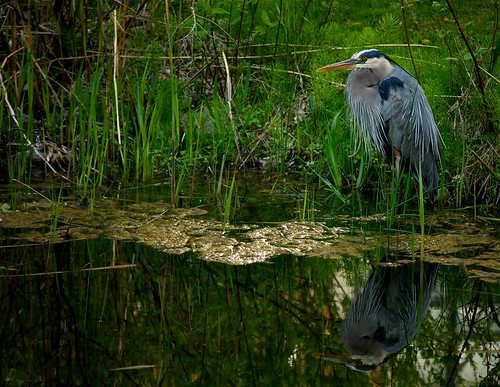
The next couple of images are part of a large series that I took of this bird catching fish, bringing it ashore, killing it by repeated pecking and checking, and then taking it back to the water to wash off the blood and soil, before devouring it.
This was my first time seeing a GBH up close, and I had spent at least an hour watching it, before it finally did something interesting. I remember having stayed around for at least another couple of hours afterwards, hoping it would take off for the evening, and I would be able to photograph it in flight. However, that didn't happen, and it happily just decided to snooze a few feet from there (the last image in this series).
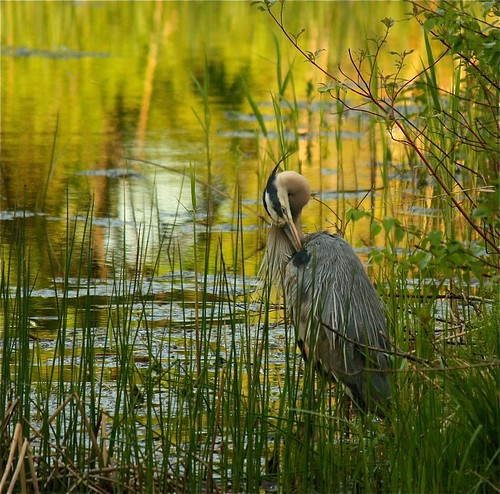
Labels:
BIF,
bird,
bird in flight,
bird photography,
bird watching,
fish,
fishing,
Great Blue Heron,
Nature,
wild bird,
wildlife
Saturday, August 13, 2011
Black-Capped Chickadee (Poecile atricapillus)
I think these tiny little birds are the cutest and most curious in the bird kingdom! They look similar to house sparrows till you get a good look at them. Very similar in size, what sets them apart is the colour of the nape and the back. The Black-capped Chickadee has a gray nape and back, whereas the House Sparrow's is reddish.
The calls are different as well, once you listen carefully. However, I sometimes confuse the Chickadee call with that of a Nuthatch, a blackbird or even a Cardinal! I have heard 3 to 4 distinctly different calls, and thereby the confusion.
There isn't any difference in the appearances of adult males or females. The distinguishing feature of this little bird is the rounded body and head, with a short bill. I have found it particularly challenging to photograph them on a cloudy day, because their black caps make it difficult to see and focus on their eyes. I am yet to get a shot that I'm completely excited about. And they also peck like woodpeckers! Read on to find out why.
It's very interesting to stand and watch their acrobatics, as these are really hyperactive birds. And if you aren't focussed, you'd miss seeing them hiding in the higher parts of a tree or getting lost in the dense foliage.
One of the many interesting facts I'd read about them (and remember!) was that other migratory birds like nuthatches, woodpeckers and kinglets flock with them and they heed the chickadees' warning calls of alarm even if they don't hear or have their own alarm calls. Saying that, it now explains how I have often spotted nuthatches very close to where I've spotted chickadees.
Another interesting thing is that they hide their food in cavities in the trees, and they come back for it later and peck into the cavities to retrieve their hidden treasure. They have a fantastic memory and remember exactly where they hid their food. They can hide food in multiple places and remember exactly where to come back for them! I could do with that kind of memory - it would really help me when I'm looking for misplaced documents, keys, or even my glasses!
I guess this chickadee was looking for its food in the image below.
The calls are different as well, once you listen carefully. However, I sometimes confuse the Chickadee call with that of a Nuthatch, a blackbird or even a Cardinal! I have heard 3 to 4 distinctly different calls, and thereby the confusion.
There isn't any difference in the appearances of adult males or females. The distinguishing feature of this little bird is the rounded body and head, with a short bill. I have found it particularly challenging to photograph them on a cloudy day, because their black caps make it difficult to see and focus on their eyes. I am yet to get a shot that I'm completely excited about. And they also peck like woodpeckers! Read on to find out why.
One of the many interesting facts I'd read about them (and remember!) was that other migratory birds like nuthatches, woodpeckers and kinglets flock with them and they heed the chickadees' warning calls of alarm even if they don't hear or have their own alarm calls. Saying that, it now explains how I have often spotted nuthatches very close to where I've spotted chickadees.
I guess this chickadee was looking for its food in the image below.
Labels:
bird,
bird photography,
birding,
black-capped chickadee,
chickadee,
shinydewdrop,
songbird
Saturday, June 11, 2011
Mallard (Anas Platyrhynchos)
The Mallard is probably the most common duck you will see around in your local water bodies. These are dabbling ducks that dip their head under water with their feet and tails sticking out, in order to search for food.
The males have an iridescent green head, a dark brown chest with a lighter body, and a bright yellow bill.
The females are a much paler brown with darker brown streaks, a dark crown and a dark eye stripe. The female Mallards can also be identified by their purplish stripe on the wing near the tips.
The ducklings have a black eye stripe and the sides of the face are yellow. They are the cutest things you'll see waddling around.
Recently, I've had the opportunity to stand and watch this duck family of six babies swimming around with their mother. I was amazed to find a lot of similarities with human babies in that they were as playful as little kids are, and extremely mindful of the mother's quacked instructions.
This young brood spent a lot of time being curious about my camera, and kept swimming up to me, but as soon as they got too close to me for their mother's comfort, the mother quacked and they immediately fell back. However, just as human babies are sometimes too curious and don't pay heed to what the parents say, one of the six came up so close to me, that I couldn't even focus any longer, my minimum focussing distance being 1.8m on the long lens.
The other thing I noted was the level of activity of these ducklings. They did a peculiar scoot over the water's surface and chased each other around.
Labels:
dabbling duck,
duck,
ducklings,
female Mallard,
male Mallard,
Mallard,
Mallard duckling,
Nature,
photography,
shinydewdrop,
water fowl,
wild bird
Subscribe to:
Posts (Atom)
